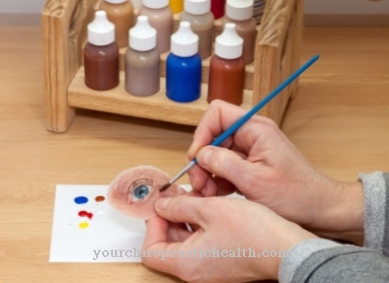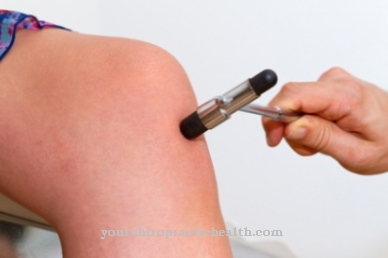At a central venous catheter it is an external access to the venous system via a large vein. The plastic tube used for this is placed centrally in front of the right atrium of the heart. The advantage of this technique is that highly irritating drugs and several drugs can be administered in parallel.
What is a central venous catheter?

Under a central venous catheter, also known by the name ZVK, one understands a central access through an inserted plastic tube (catheter) into a large vein. Veins in the neck or collarbone area are often used for this. The end of the plastic tube is just in front of the right atrium of the heart and is therefore 'central' in the person.
The central venous catheter enables intravenous drug administration and diagnostic procedures, such as measuring central venous pressure.
This form of access to the venous system is used in intensive medicine and emergency care. Within Germany, an average of 4110 central venous catheters are placed every day. It is one of the most frequently used products in the field of medicine.
Shapes, types & types
A central venous catheter is differentiated by size. The later application is decisive for this. Three to five-lumen venous catheters are most commonly placed. Later uses can be parenteral high calorie nutrition or chemotherapy.
Via the individual lumens, it is possible to supply several drugs or liquid food to the patient in parallel without the individual substances becoming incompatible. It should be noted that the risk of infection increases with the number of lumens. The actual use of lumens should therefore be analyzed beforehand and the duration of use should be kept as short as possible.
The placement of a CVC should be performed by an experienced doctor. The general condition and any injuries of the patient should be considered. In addition, sterile conditions for placing a catheter should be provided. If a central venous catheter has to be carried out as an emergency measure, careful maintenance must then be observed. The CVC dressing should be changed regularly and the puncture site should be checked for redness and swelling.
There are many options for access routes. However, preference is given to the internal jugular vein on the neck or the subclavian vein below the clavicle (collarbone). Alternatively, access via the basilic vein on the arm or the brachiocephalic vein on the neck is also possible. Accesses are rarely made in the elbow veins or in the groin area.
Structure & functionality
The following materials are required to insert a venous catheter: sterile gloves, a gown and a face mask, sterile drapes, a local anesthetic, a scalpel, scissors, tweezers, a needle holder, sutures, sterile bandages and a puncture set flushed with saline.
If a central venous catheter has to be placed, the puncture region is inspected by the attending physician; this can also be done with a sterile ultrasound device. Then the area around the puncture site is numbed locally with an anesthetic.The venous catheter is inserted blindly under sterile conditions. If the access is in front of the right atrium, it is flushed with a saline solution and fixed with a CVC bandage. A position check can be carried out by ultrasound or X-ray, in this way a pneumothorax can be excluded if necessary.
The patient should be connected to an EKG machine during the procedure because myocardial irritation can lead to tachycardia or cardiac fibrillation. If the catheter is in the wrong position or if the CVC is reversed intravascularly, the plastic tube is not in front of the right atrium of the heart. This can cause bruising or perforation of the vein. This can rarely damage arteries or nerves. An incorrect position can also lead to cardiac arrhythmias or an acute tension pneumothorax. This can potentially cause life-threatening injuries.
Other undesirable side effects, such as catheter sepsis, can occur. This can be triggered by a bacteremia (bacteria) or a fungemia (fungal infection). In addition, if air enters the central venous catheter, complications in the form of pulmonary embolism, thrombus formation or thrombophlebitis can occur. General symptoms such as fever, pain, swelling, and aspiration can indicate possible complications.
Medical & health benefits
A central venous catheter is used to administer infusion solutions or drugs that have a strong irritant effect on the vein walls. This can be, for example, potassium chloride, sodium hydrogen carbonate (sodium bicarbonate) as well as glucose or amino acids. These substances irritate the veins too much to be administered through a peripheral venous catheter. It can also be cytostatics, antibiotics, drugs with short half-lives or long-term infusion therapies lasting more than 10 days.
Not only irritating substances, but also infusion solutions for cardiovascular stability often have to be administered via a CVC. If a peripheral venous catheter is to be placed, a central venous catheter is often placed as an alternative in poor venous conditions in order to prevent possible perforations.
Indications for a central venous catheter are all types of shock, such as a volume deficiency shock (hypovolemic shock), cardiogenic shock or septic shock, hypothermia (hypothermia) or extensive burns. Furthermore, the central venous pressure can be measured with the help of a CVC and the intravascular volume status and the right ventricular function can be assessed.

















.jpg)



.jpg)

.jpg)




